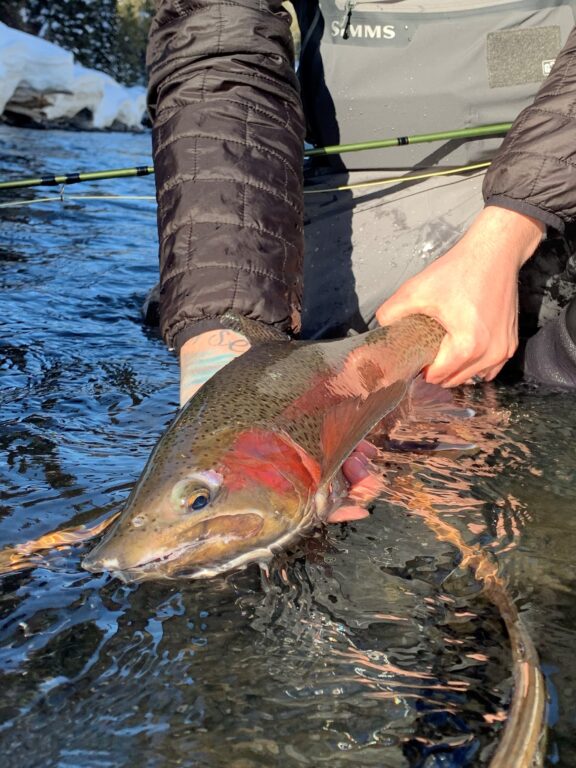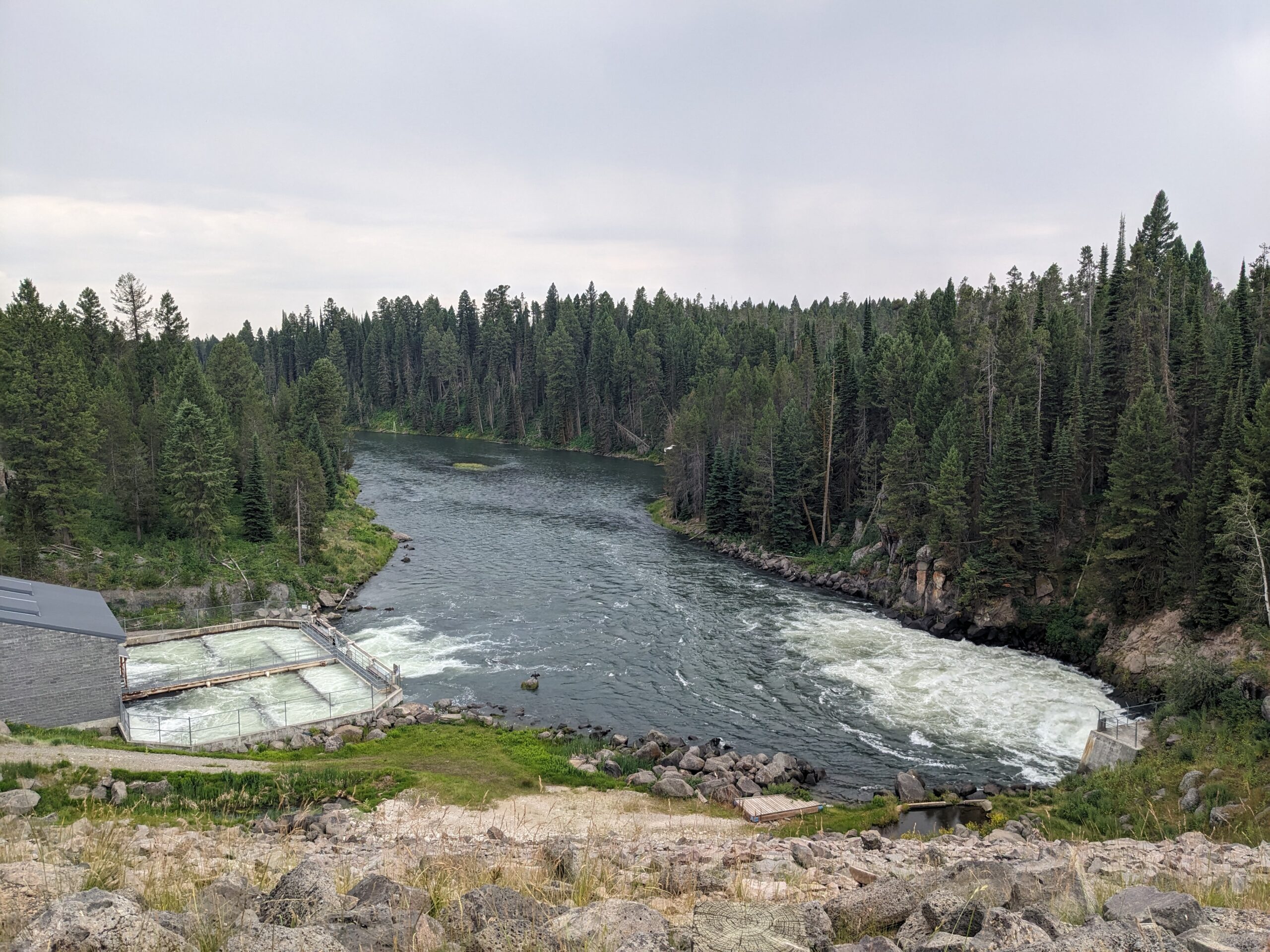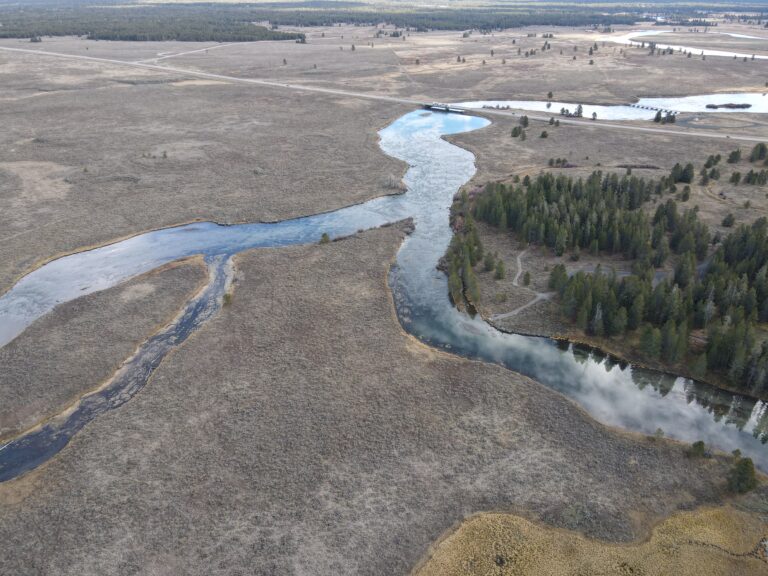UPDATE: After 10 years of studying Island Park Reservoir, we thought we had seen just about everything possible, but the current event is apparently something we have never seen in those 10 years.
Previous turbidity events have fallen into three categories: 1) textbook “turnover” events, 2) excessive growth and decay of algae and/or cyanobacteria (aka “blue-green algae”), or 3) density currents caused by rapid surface cooling on the West End that transport bottom sediments to the dam. Given weather and reservoir conditions over the past month, we know that the current event doesn’t fall into categories 1 or 3. As of last Friday, we assumed that left only category 2 as a possibility—a large algae bloom.
However, HFF’s Aquatic Ecologist Dr. Jack McLaren was out on Island Park Reservoir this past weekend and his sampling showed us something different. Algae and cyanobacteria growth is relatively low, and dissolved oxygen throughout the water column is the highest we have ever seen this time of year. Further, turbidity in the reservoir is very low for this time of year.
The new twist is that growth of rooted aquatic vegetation (“macrophytes”) is the highest we have ever seen in the reservoir. While much more desirable than algae growth, apparently the decay of this vegetation in the reservoir is depositing a lot of organic material on the bottom of the reservoir, and this is what is making its way into the river.
Other data corroborate this as the source of the current turbidity. Most of it is being consumed by insects and other organisms that live on the bottom of the river downstream, but as mentioned above, some of it is staying in suspension all the way downstream of Ashton Dam. By contrast, the 2020 event transported mostly mineral sediments, not decaying plant matter.
We know that high turbidity has a negative effect on our fishing experience on the Henry’s Fork. However, the current event does not appear to pose any short-term risks to fish or insects.
Although aesthetics and fishing experience were definitely negatively affected by the recent two-week turbidity event, our greatest concern during the event was low dissolved oxygen (DO) associated with high biological oxygen demand as the organic material that comprised most of the suspended material was processed in the river. We understand that turbidity and water temperature receive much more attention from river users because those factors can be easily observed or measured without sophisticated instruments. However, at the levels we have observed in the Henry’s Fork over the past 10 years of careful monitoring, neither turbidity nor temperature have any potential for short-term negative effects on survival of fish or insects. On the other hand, drops in DO can quickly kill fish and other aquatic life. Fish cannot detect such drops and would have little in the way of refuge areas in which to seek better conditions even if they could.
Our sondes at Island Park Dam and Pinehaven have not detected any DO concentrations even close to the stressful threshold throughout this recent event or at any time all summer for that matter. However, these sondes only bracket the reach of interest, and it is possible that DO levels could fall below the stressful threshold at other locations in between. Because DO is such a concern to us, we have used a spare sonde in our fleet to do some spot checks of DO during the early morning hours when it is at its minimum.
We focused on areas at Osborne Bridge and Last Chance, where dead fish were observed last week. At all areas, DO was above 6 mg/L and was consistent with DO readings at our sondes at Island Park Dam and at Pinehaven. In fact, DO, temperature, and turbidity recorded at intermediate locations between the dam and Pinehaven fell right in between the readings at those two endpoints. This adds to a growing body of evidence we have collected over the past 10 years that outflow from the reservoir sets the baseline water-quality conditions at the top of the reach and that from there to Pinehaven, the ecosystem is dominated by interaction with the atmosphere (temperature and solar radiation) and the daily cycles of photosynthesis by rooted aquatic vegetation.
The take-home messages here are: 1) turbidity looks bad and water temperatures are warm, but neither are going to kill fish. 2) Dissolved oxygen, which has the potential to kill fish, is well above stressful thresholds all day throughout the reach. 3) With a few localized water-temperature exceptions (generally much cooler water near groundwater inputs), water-quality conditions between the dam and Pinehaven fall somewhere between those observed at the Island Park and Pinehaven sondes. So, a quick check of those on our water quality website give you 90% of the picture of what is going on in between.
As for the dead fish, we first heard reports of dead fish on Thursday morning at the Last Chance boat ramp. We observed them ourselves on Friday at Last Chance and Osborne Bridge and heard reports of dead fish at Last Chance last Friday. We spent time looking for more of them on Monday and collected all of the ones we could find—all from Last Chance. Every one of the fish we observed on Friday and Monday were juvenile whitefish, and the other reports we received were consistent with this. All fish appeared to have died in the middle of last week.
From a variety of evidence, we believe that the source is the Buffalo River at the hydroelectric power dam. Aquatic vegetation growth has been so heavy there this summer that the power plant has been unable to operate. Fall River Rural Electric has been periodically drawing down the forebay for an hour or two and raking vegetation to attempt to clear it from the power plant intake. The last such operation took place last Wednesday morning. We know from our operation of the Buffalo River fish ladder that the Buffalo River supports large numbers of juvenile whitefish, and it is likely that Wednesday’s operation displaced the juvenile fish from the forebay, especially if they were using beds of aquatic vegetation as cover.
Regardless, we would appreciate any reports of dead fish from people out on the river. Please send location and time, along with definitive identification of the species and close-up photos, if possible. Thank you for your help in protecting this incredible fishery.
—————————————————————————————–
Originally published 08/02/24
Anglers are reporting high levels of turbidity coming out of Island Park Dam and even sightings of a few small, dead Whitefish near Last Chance.
Turbidity is a measure of how clear or cloudy the water is, with higher turbidity indicating cloudier water. Turbidity can also be organic, coming from algae or cyanobacteria, or inorganic, coming from mineral sediment.
HFF’s water quality monitoring network is registering the highest turbidity in Island Park Dam outflow since the September 2020 turbidity event. The 2020 event was mineral sediment being transported, but this event is resulting from high algae growth in the reservoir, indicated by high chlorophyll concentrations in sonde data downstream. After experiencing good water quality for most of July, the combination of hot, calm sunny weather and low inflow is producing very high algae growth in the reservoir. So far, this algal growth (or algal bloom) is not cyanobacteria.
While turbidity is in the range of 10–15 turbidity units at the dam, it is only around 6–7 at Last Chance and 5–6 at Pinehaven. This indicates that most of the organic material is being either consumed by aquatic invertebrates (bug food!) in the river or settling out in beds of aquatic vegetation.
Looking ahead, we still do not anticipate any destabilizing events that could transport bottom mineral sediment to the dam, but it is likely that the current high algae production in the reservoir will continue for several more weeks.
Are the reports of dead fish connected to turbidity?
While turbidity isn’t causing fish kills, their root cause may be the same. The combination of warm water temperatures and low dissolved oxygen are stressful on fish, but it’s the lack of oxygen that causes the “fish kill”. HFF’s water quality network is not showing stressfully low levels of dissolved oxygen in the river downstream.
When the reports of dead fish came in, Science & Technology Program Director, Dr. Rob Van Kirk headed out to put eyes on the situation. Rob personally captured several of the dead fish, 3-5 inch “pencil-shaped” Whitefish, as he worked his way along the river in Island Park, including Last Chance, the Logjam and Osborne Bridge. A few factors helped Rob and Aquatic Ecology Program Manager, Dr. Jack McLaren feel confident that the deceased fish seen were Whitefish. First, the pencil shape, more characteristic of young Whitefish than the round, almost-as-wide-as-they-are-long shape of young trout. And second, based on spawning timelines, this isn’t the time of year you would expect to see 3-5” trout in the river.
That said, if you’re out on the Henry’s Fork in the coming days and weeks, please report any and all dead fish you see (and thank you to the anglers who reported this!). A time, location, and photo ID of the fish will really help. Jack (Aquatic Ecology Program Manager) will head out on the reservoir to conduct reservoir profiles and collect data to assess dissolved oxygen levels, the algal bloom, and develop an estimate of how much longer this might last.
Also, please remember that on the Henry’s Fork, peak dissolved oxygen occurs when the sun is at it’s peak (aquatic plant growth) around 3 or 3:30 PM, but water temperatures continue to rise until 7 or 8 PM. This is why anglers might consider limiting their fishing after about 4 PM, as this is the most stressful time for fish on the Henry’s Fork. Late morning tends to be the least stressful, as dissolved oxygen is on it’s way up, but water temperatures are still relatively cool.






